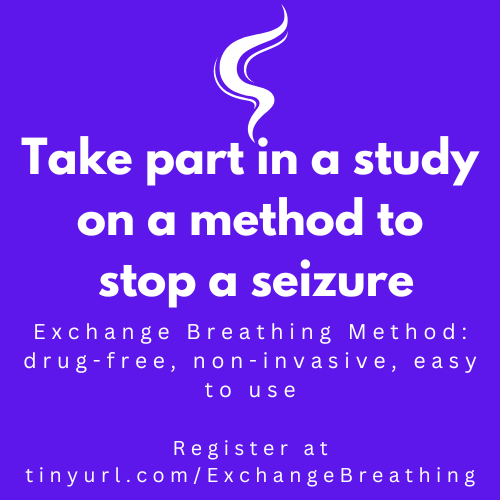Just over a decade ago, Gemma Herbertson, founder of Neuro Frontiers, and Chair of the Answers & Hope charity, invented a first aid method to stop a seizure. It is called the Exchange Breathing Method (EBM) and is drug-free, non-invasive and cost-free. Via the power of social media, hundreds of people around the world have started using the method. Now, a group of scientists from three institutions, including Harvard Medical School, are going to be conducting research into EBM; and are appealing for people to take part in the study, which could help millions around the world.
Around ten years ago, Gemma’s son was going through a really tough time, having around 500 seizures a week, day and night, and this went on for a number of years. As Gemma recounts,
“He had tried so many different medications, which had not worked. As a family, the stress of dealing with seizures and the severe sleep deprivation, challenged our lives so much; but it also motivated me to seek answers.”
By her son’s bedside, she spent hours researching for anything which might help.
“By some miracle, and particularly inspired by Bernhard Rohrbeck, a fellow carer of someone with seizures, and crazy though it sounds, I invented a method to stop a seizure: the Exchange Breathing Method. It is a non-invasive, drug-free method, and is so easy to do, almost anyone can use it (even a child).”
Full instructions (which should be consulted) are available on the Neuro Frontiers website (link below), but essentially, the first aider just needs to give a puff of their exhaled air into the nose of the person having a seizure.
With her own son, Gemma had many opportunities to test out the first aid method.
“Instead of my son taking hours to recover or calling an ambulance and ending up in hospital, pumped full of drugs, I would simply use EBM. His seizure would then quickly stop, and he would be able to continue his day. It was hugely life-changing for all of us. I wanted others to benefit, so I shared my experience online and now hundreds of others with seizures experience this quality-of-life changing tool as well.”

Take part in a study on a method to stop seizures, epilepsy
Though helping many people is clearly worthy, Gemma and her fellow Trustees at the Answers & Hope charity, would like to do more: 50 million people around the world suffer from epilepsy, and so this is a lot of lives (plus those of their carers’ and families’) which could benefit from this easy-to-use method. And, because for so many users, the method stops a seizure in its tracks, it is now the ambition for the Exchange Breathing Method to become the worldwide first aid method for a seizure.
The first step in achieving this, is for independent research into the method to take place. There was hence huge gratitude when the method raised the interest of a Harvard Professor of Neurology, Ted Carrick; and now, in partnership with researchers from Harvard Medical School, University of Central Florida College of Medicine and the Carrick Institute, USA, this research group will be conducting independent research on this novel first aid method for a seizure. For this to take place, they now need people to join the study, as this offers the greatest chance to help the 50 million people around the world who experience seizures.
So, if you have seizures, or know someone who does, and would like a non-invasive, drug-free seizure first aid method, then please consider signing up for this study. It is open to both individuals and carers. The person can come from anywhere in the world, be of any age, have any seizure type, and does not need to be verbal or able to follow instructions (the first aider just needs to be able to do this). They can also remain on any current medical diet or medications. The link to register for the study is here:
https://tinyurl.com/ExchangeBreathing/
More information on the Exchange Breathing Method is here: https://www.neurofrontiers.org/natural-methods-to-halt-seizures/exchange-breathing-method/
An online group can be found here: https://www.facebook.com/groups/EBMFirstAid
Questions about the research can be directed to drfrcarrick@post.harvard.edu
FAQs
1 Who can take part?
You can register for the study if you are someone who has seizures, OR if you care for someone who has seizures (this can be as a professional or as a loved one, such as a parent).
2 Can participants come from anywhere in the world?
Yes, for this initial part of the project, people can live anywhere in the world and still take part.
3 What ages are you looking for?
Any age (newborns to 100yrs+) can take part.
4 What type of seizures can be included in the study?
The researchers are keen to hear from people dealing with any seizure type. The study is interested to establish whether EBM can work for all seizure types and/or where its limitations are.
5 I’ve not used EBM yet, can I take part?
Yes, you are welcome to take part in the study.
6 I used EBM in the past and wasn’t sure if it worked. Can I still take part?
Yes, please! The study will help to refine the knowledge of the method, when it works, for whom, etc. Please share ALL experiences
7 Do I need to come off any medications or medical diet or interventions such as VNS in order to participate?
No, you can CONTINUE to remain on any meds or specialist diet or to use any other medical interventions such as VNS.
8 Where do I sign up to take part?
https://tinyurl.com/ExchangeBreathing
9 How do I use the Exchange Breathing Method?
Instructions and video are here:
https://www.neurofrontiers.org/…/exchange-breathing…/
9 Can I let others know about this study?
Yes please! We would be so SO grateful for any ways that you can spread the word on the Exchange Breathing Method (like many of you, I am a full-time carer to my son, so any help is much appreciated). You can find links to repost and share here :







